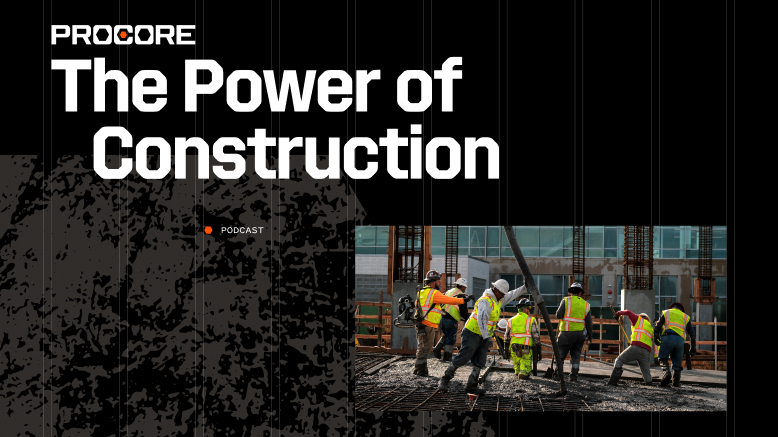— 9 min read
Key Types of Estimates in Construction


Last Updated Dec 3, 2024

D. Jesse Mase
Principle Operational Excellence Specialist
10 articles
D. Jesse Mase has a wealth of experience spanning architecture, construction, and real estate investment. His passion for the built environment led him to self-employment as a design builder, and later, managing large-scale commercial construction projects at Trehel Corporation. Currently, Jesse leverages his industry insights in his role as Principal Strategic Product Consultant at Procore, streamlining processes and solutions for construction project owners.

David Giali
Content Manager, NAMER
11 articles
David is a Content Manager for North America at Procore Technologies. He is an experienced writer in the software industry with close to 1000 published articles. Before writing, he worked in for a specialty contractor as an estimator and finish contractor. David spends his time outdoors with his wife and dog, experimenting with film photography, and writing music.

Ben Ashburn
Staff Trainer & Program Manager
22 articles
Ben Ashburn is a Senior Construction Education Trainer at Procore. After a successful career as a construction estimator — working his way up from estimating manager to senior estimator — Ben has spent the most recent part of his career in construction sharing his skills with other as a construction educator. Ben has an extensive background in construction education: He has been an assistant professor in the Department of Construction Science at Texas A&M, and lectured about estimating, scheduling, management, and other related construction topics at Murray State University. He has been a construction training and learning development partner with Procore since 2019.
Last Updated Dec 3, 2024

The challenge of determining the cost of building a construction project can seem like an impossible task. Considering the unique nature of each project and the fact that material and labor prices change constantly, it’s virtually impossible to calculate future rework or delay costs. It’s as if estimators have some kind of psychic ability just to be in the ballpark.
Estimation isn't a single process that occurs one time during a construction project. Rather, estimation happens in different forms at various stages throughout a project's lifecycle. These estimates not only help in defining budgets but also become pivotal in tracking actual project costs against planned expenses. Here's an in-depth look into the different types of construction estimates and how they are applied across various project delivery methods.
Table of contents
4 Stages of Construction Estimating
There are many ways to estimate how much a job will cost, especially considering the different types of contracts between owners and general contractors that contribute to what estimating looks like. As the project moves forward through design phases and then into construction, estimators will continue to reassess estimates in greater and more granular detail.
Depending on the stage of the project, a different type of estimating will be used. In most cases, a larger job will consist of the following types of estimates: conceptual, detailed, quantity and bid.
1. Conceptual Estimates
At the outset of any construction project, a primary concern for owners is establishing a clear and accurate estimate of project costs. Conceptual estimating is that foundational step that influences project funding, budget planning and design development, setting the stage for the financial viability of a project.
Conceptual estimating, sometimes referred to as cost modeling or preliminary estimates, is a preconstruction exercise, focused on forecasting project costs before detailed project design and engineering is completed. This process often begins during the predevelopment phase of a project — or as part of a pro forma — to ensure financial viability. These early estimates are essential for setting initial construction budgets, assessing project feasibility, guiding the design process and supporting strategic decision-making.
Estimators collaborate closely with architects and project owners so each design iteration remains aligned with the project's architectural intentions and budgetary goals. These early estimates guide cooperative design adjustments, helping project teams make informed decisions that balance aesthetic desires with financial constraints.
The first step is often to conduct a quick feasibility study. The client might say, 'This is a piece of land, and I want to build this type of structure.' We would then perform a quick code study to verify if the proposed construction is feasible on that land and if it aligns with the client's budget, even before detailing the costs of materials like bricks. Our team conducted a conceptual estimate to determine whether the client’s needs could be met within the set budget, and we found that they could. Then, I began working through the bids for the major costs like concrete, steel and grading. These significant costs didn't change much after the initial estimate.

D. Jesse Mase
Principle Operational Excellence Specialist
Procore Technologies
Detailed Estimates
Detailed estimates will be conducted after the preliminary and conceptual estimates have established basic feasibility and scope. These estimates provide a more precise and thorough financial projection, laying the groundwork for a more accurate and reliable budget for owners.
Detailed estimates involve an in-depth analysis of all aspects of the project, taking into account a comprehensive list of materials, labor and associated costs. This phase transitions from high-level estimates to specific costs, often using data from previous projects, current market rates and detailed project drawings. It includes precise measurements and quantities, such as square footage for flooring or linear feet for piping, and multiplies these units by their respective costs.
Detailed estimates might initially start with broad approximations. Earlier estimations might consist of a document from a trade partner promising to do the sheetrock and all the insulation. As the project progresses, estimates might get broken out into sets based on materials and methods they’ll use – often called the "30, 60, and 90 sets" – which are increasingly more accurate based on the percentage of detail given.
The 30, 60, 90 set often goes in one of two ways. Sometimes people go to three bidders and ask them to provide 30% pricing, meaning they're not going to take off every square inch, but they're going to put a rough number on it with a moderate level of certainty based on the scope of the work, like the average square feet of coverage.
Quantity Estimates
Quantity estimates focus on calculating the specific quantities of materials and labor required for the project. These estimates are usually derived from detailed project drawings and specifications, using tools like on-screen — material takeoffs or 3D takeoffs — to measure areas, lengths and volumes.
General contractors typically perform takeoffs to create accurate work packages, either to complete themselves or assign to specialty contractors. A specialty contractor usually reviews the plans specifications to perform their own material takeoff, ensuring they have an accurate count before reaching out to suppliers and vendors.
After completing a takeoff, estimators have a comprehensive list of every material required to complete the project. They also use information from the takeoff to determine what equipment will be needed for each work package.
Explore data and trends for building materials prices.
Get the latest U.S. retail prices and view historical trends for common building materials.
Bid Estimates
After the cost of the project has been determined front her takeoffs and conceptual and quantity estimates, general contractors then need to determine how much to bid. This estimate will take into consideration all of the indirect costs a general contractor will take on — such as overhead, labor, insurance and bonding, permits, site cleaning, etc. — as well as accounting for profit and contingency.
After calculating all of the costs for a construction project, the estimator will adjust the total to account for both profit margin and contingency. The profit is the fee that the contractor earns for the contract—and that money can be reinvested to continue growing the business. Contingency, on the other hand, is a portion of the contract set aside for overruns and waste — which are generally to be expected on a construction project.
When owners receive a bid from a general contractor, while that is an estimate of the work, it's not really an estimate; it's the number they will agree to sign on, and contractors will then build it for the agreed number, come hell or high water. At this point, we're out of the estimated territory, and it becomes a contractual document.
D. Jesse Mase
Principle Operational Excellence Specialist
Procore Technologies
How Project Delivery Methods Change Estimates
The process behind building out construction estimates and who will complete each iteration will depend on the construction delivery method the project uses.
Design-bid-build
Design-bid-build (DBB) is the traditional construction delivery method. On a DBB project, an owner would work with a design team to sketch out the idea for a new project and then have general contractors bid on the project based on their own estimations.
Often, owners will ask the designers to create rough conceptual estimates to use to create budgets for lenders and stakeholders — but, for the most part, it’s during the bidding process that owners will have a greater understanding of how much the project will actually cost them.
Design-build
The design-build (DB) delivery model allows for much closer collaboration between designer, owner and contractors early on in the construction design process. In this case, it's very common to put together a Guaranteed Maximum Price (GMP) as the design process goes along, so that they can notice when costs start to get out of hand and change the design to limit those costs.
The owner and the architect both experience the benefits of creating more informed early project estimations. The owner benefits by getting a sense of costs earlier on in the process, and won't get too attached to any idea that's totally unaffordable.
Meanwhile, the architect has a greater likelihood of the design actually getting built, because the owner, architect and contractor are working together on a design that will max out the design capacity while staying within budget.
Over the course of a DB project, there will be various versions of project cost estimates.
Cost escalation in estimations
After an owner and a design-build firm have both signed off on a budget, the total costs of the project as scoped out in the contract become the construction firm's responsibility, regardless of any cost increases like the cost of materials.
Some contractors will answer this challenge by firming up all those materials contracts as soon as the project begins. That way, the liability for price increases falls to the materials suppliers who have guaranteed their prices. Contractors who don't buy their contracts out will need to do more frequent internal estimating (that they won't share with the owner) as the project progresses so that they are aware of any spiking prices and don't get snowed under with price increases when it comes time to actually procure the materials.
Some construction projects with very long lead times may be contracted with price escalation clauses that outline how those extra costs may be handled between the owner and the contractor.
Change order estimations
No construction project is without surprises. As work begins, there will be items that come up that will require more work than the original scope allowed for. In those cases, the build team will ask for estimations on the cost of the extra work that eventually become change orders.
For instance, if the build team starts digging and identifies some bad soil, they will get experts to identify the approximate yardage of the bad soil and get estimates from subcontractors to dig it out.
How Technology is Changing Estimation
Access to information about past projects may drastically change the way that owners think of the design-build teams they hire to build their projects. Technology is now allowing savvy construction firms to access huge swaths of fresh information and analysis from past work, which helps inform new projects.
Firms with access to data can look at a particular square footage of a project like a hospital, and based on the last four projects extrapolate exact costs. Any issues that arise can be solved as cost-effectively as possible using this project data, and DB firms are able to use the data to suggest the cheapest way to fix the issue. And with new virtual design and construction (VDC) programs, it’s not a pipe dream that estimation can be an automated process based on building information modeling (BIM) and integrated cost data.
Information like that may avoid a great deal of risk for the owner. With all the metadata that's going into digital storage, it would stand to reason that owners will, in many cases, choose the design-bid firms with the most data.
As technology advances, construction software is beginning to enable users to see and analyze data, plus complete rudimentary takeoffs using building plans.
Was this article helpful?
Thank you for your submission.
100%
0%
You voted that this article was . Was this a mistake? If so, change your vote
Scroll less, learn more about construction.
Subscribe to The Blueprint, Procore’s construction newsletter, to get content from industry experts delivered straight to your inbox.
By clicking this button, you agree to our Privacy Notice and Terms of Service.
Thank you!
You’re signed up to receive The Blueprint newsletter from Procore. You can unsubscribe at any time.
Categories:
Written by

D. Jesse Mase
Principle Operational Excellence Specialist | Procore Technologies
10 articles
D. Jesse Mase has a wealth of experience spanning architecture, construction, and real estate investment. His passion for the built environment led him to self-employment as a design builder, and later, managing large-scale commercial construction projects at Trehel Corporation. Currently, Jesse leverages his industry insights in his role as Principal Strategic Product Consultant at Procore, streamlining processes and solutions for construction project owners.
View profile
David Giali
Content Manager, NAMER | Procore Technologies
11 articles
David is a Content Manager for North America at Procore Technologies. He is an experienced writer in the software industry with close to 1000 published articles. Before writing, he worked in for a specialty contractor as an estimator and finish contractor. David spends his time outdoors with his wife and dog, experimenting with film photography, and writing music.
View profileReviewed by

Ben Ashburn
Staff Trainer & Program Manager | Procore Technologies
22 articles
Ben Ashburn is a Senior Construction Education Trainer at Procore. After a successful career as a construction estimator — working his way up from estimating manager to senior estimator — Ben has spent the most recent part of his career in construction sharing his skills with other as a construction educator. Ben has an extensive background in construction education: He has been an assistant professor in the Department of Construction Science at Texas A&M, and lectured about estimating, scheduling, management, and other related construction topics at Murray State University. He has been a construction training and learning development partner with Procore since 2019.
View profileExplore more helpful resources

How Close Are We to Bridging the Design-Build Divide?
For decades, construction decisions have often been made based on gut instinct. But what if the real barrier to transformation isn’t technology—it’s the divide between design and construction? In episode...

What Happens When Data Drives the Business?
Construction has long been seen as a low-margin industry. But what if the real problem isn’t the margins—it’s how decisions get made? In episode 17 of The Power of Construction,...

Preconstruction Partnerships: How Safety Pros Can Collaborate with Estimating & Proposal Teams
Construction leaders and safety professionals are developing a strong understanding of how safety programs positively impact project outcomes. When safety is woven into every aspect of operations from pre-construction to...

Estimate vs. Budget: Tools to Guide Construction Financial Planning
Whether building a residential home, a commercial complex or a large-scale infrastructure development, understanding and managing costs is key to completing a project on time and within financial limits. Effective...
Free Tools
Calculators
Use our calculators to estimate the cost of construction materials for your next project.
Templates
Find a template to help you with your construction project tasks.
Material Price Tracker
Get the latest U.S. retail prices and view historical trends for common building materials.
Glossary
Explore key terms and phrases used in the industry.
